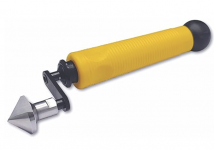Michael Kellough
Member
I’m going to be using the Shaper Origin to cut out a router plate from 1/4” 6061 aluminum (for a flattening sled) and want to go ahead and countersink the holes while the SO knows where they are. Hopefully just change bits and run Online or a little inside.
Some of the screws will be M6 so a regular 90* carbide V bit should work but the screws for the Milwaukee router are UNC 10-24 and the angle is 82*.
Would the 90* countersink be okay for the 10-24 screws or is there a bit that can cut 82*and can run in a router? (Shaper Origin is basically a router in the clutches of a little CNC)
Some of the screws will be M6 so a regular 90* carbide V bit should work but the screws for the Milwaukee router are UNC 10-24 and the angle is 82*.
Would the 90* countersink be okay for the 10-24 screws or is there a bit that can cut 82*and can run in a router? (Shaper Origin is basically a router in the clutches of a little CNC)

